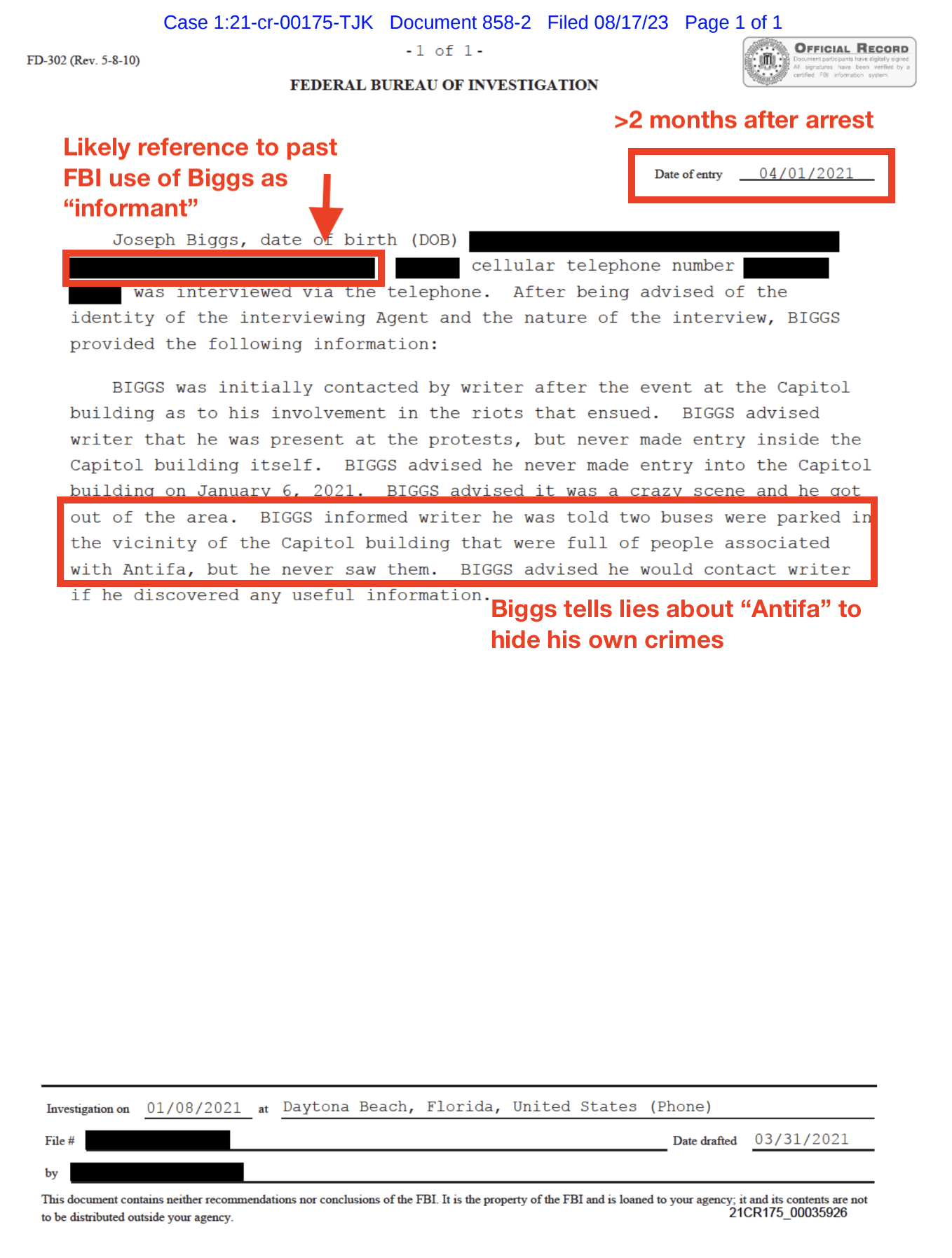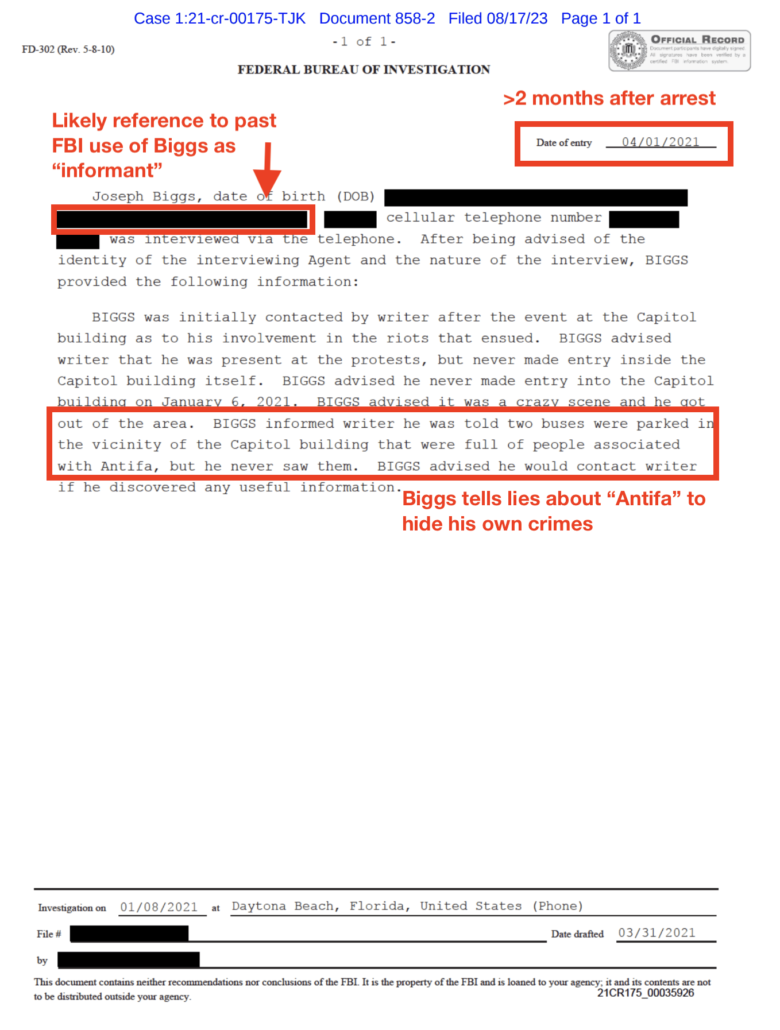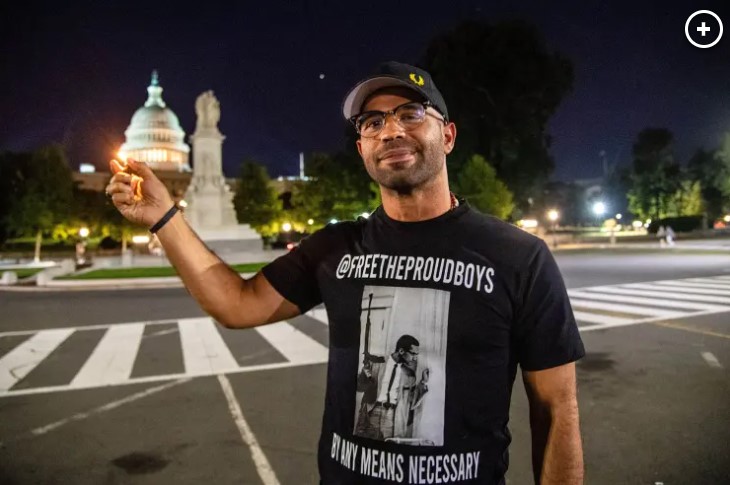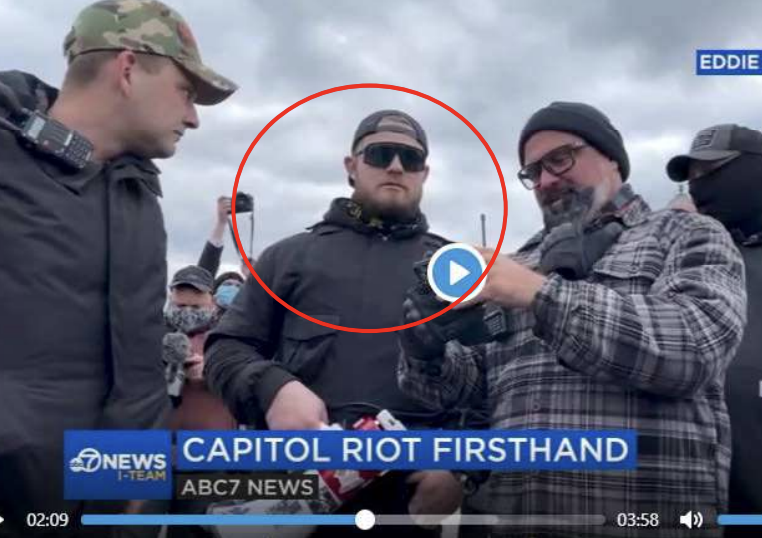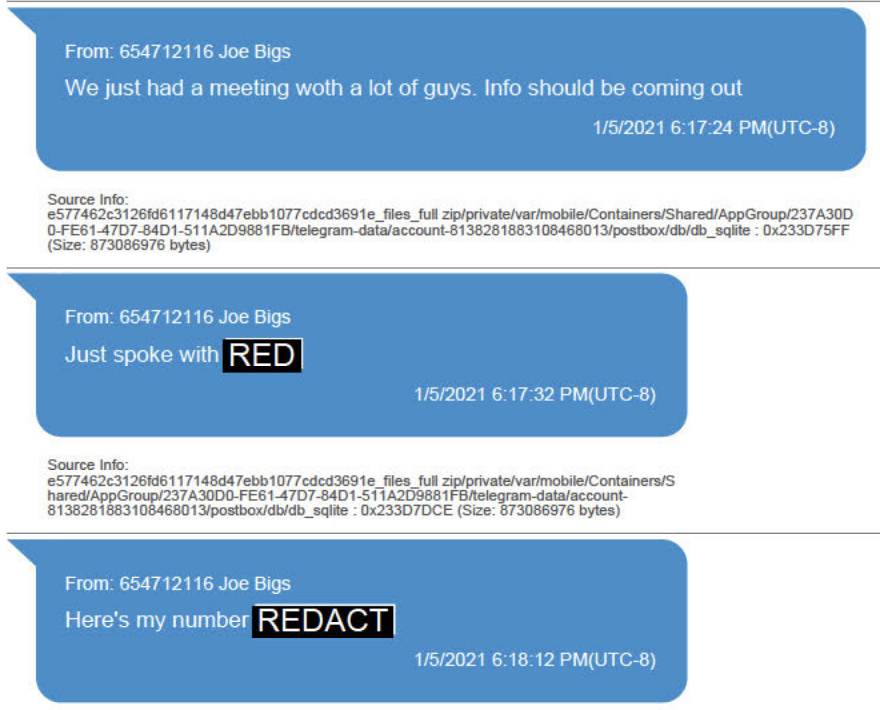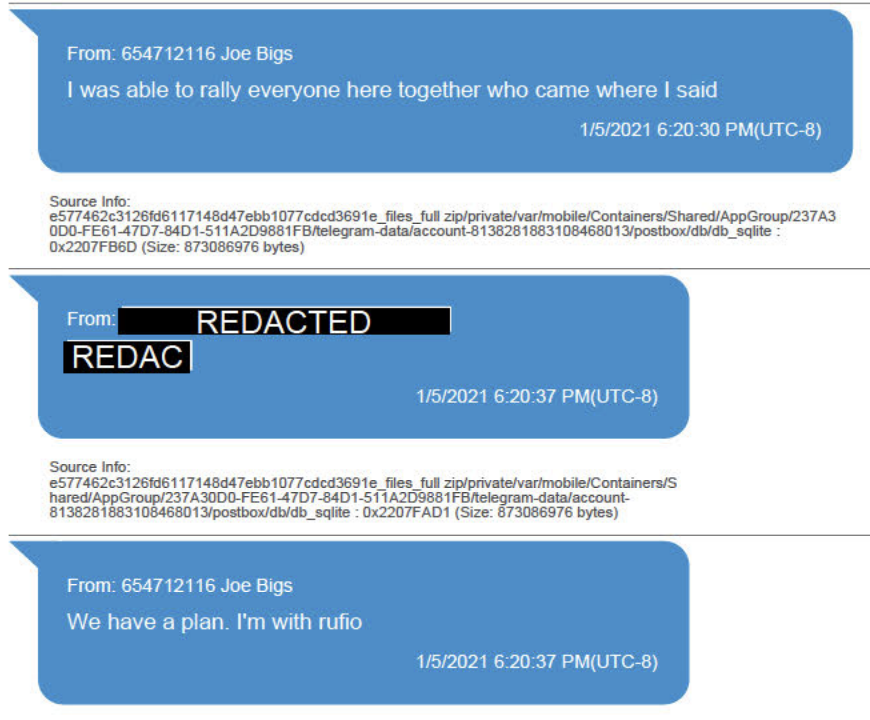“They Spoke Often:” It Took the Fash-Friendly FBI Over Two Months to Document the Lies Their Informant, Joe Biggs, Told them
The most telling detail released in DOJ’s sentencing package for Joe Biggs is this — the first 302 from after he led an attack on the nation’s Capitol, memorializing an interview done on January 8, one day after the first Proud Boy, Nicholas Ochs, was arrested.
DOJ included it — and excerpts from a second recorded interview from January 18 — to substantiate a 2-point obstruction enhancement to his sentence.
Biggs denied being with anyone he knew while he was inside the Capitol. Id. at 19:50 et. seq. (Q: “were you with anybody?” A: “No. I was lost. Like I didn’t know where to fucking go. I was by myself and I was scared shitless.”).
Biggs was asked again later in the interview whether there was anyone else with him. Biggs again claimed that he was separated and didn’t see anyone else he knew until after he left the Capitol. Id. at 25:45 et. seq. (Q: “Was there anyone else in your group that was in the Capitol?” A: [Pause] “Um, I mean, there had to have been.” Q: “You said you got separated, right?” A: “Yeah. I got separated. I didn’t see people until afterwards. I finally found people scraggling [sic] around running, you know, looking for people like me.”)
After initially denying breaking anything, Biggs was asked again whether there was anything else that was “worth sharing.” Twenty-four minutes into the interview, Biggs acknowledged “shaking” a black metal fence, but he claimed that he was only doing it because people were getting “pinned [] against it.” Id. at 24:25 et. seq. (Biggs: “I was shaking [the fence] at one point to get it loose so people could move and wouldn’t get pinned up against it” Biggs: “There was one guy who was pinned up against the fence like literally screaming; the pole was dug into his belly, and there was so much force from all the people around him, he couldn’t even breath . . . I thought that dude was gonna get hurt bad.”)
The sentencing memo suggests that Biggs victimized the FBI with these lies.
But there’s a backstory, one Biggs himself told over two years ago, in a filing submitted on March 29, 2021, in a bid to stay out of pre-trial detention.
As Biggs told the story then — two days before this 302 was finalized — Biggs would routinely reach out to cops before the Proud Boys would stage an operation, much as Enrique Tarrio did with Shane LaMond, a DC cop now being prosecuted for giving Tarrio inside tips about the investigation into him.
The same year, 2018, after the move to Florida, Biggs became active as an organizer, event planner and thought leader in the Proud Boys. He used his platform as a radio and social media personality to promote Proud Boy events and ideas. In particular, he personally planned two major events: rallies in Portland, Oregon in both 2019 and 2020 designed as counterdemonstrations against Antifa, which had been active in and around Portland for over two decades. See generally, MARK BRAY, ANTIFA: THE ANTI-FACIST HANDBOOK (August 2017) (history of Antifa networks in the Americas and Europe by social historian and Dartmouth College lecturer); L. Magelson, “Letter from Portland: In the Streets with Anitfa,” The New Yorker (Nov. 2, 2020 issue). As part of the planning, Biggs would regularly speak with by phone and in person to both local and federal law enforcement personnel stationed in Portland, including the FBI’s Portland Field Office. These talks were intended both to inform law enforcement about Proud Boy activities in Portland on a courtesy basis but also to ask for advice on planned marches or demonstrations, i.e., what march routes to take on Portland streets, where to go, where not to go. Similar conversations were held regularly with local police and FBI personnel for less major events in other cities.
As Biggs described it, rather than cracking down on the right wing group that would go on to lead an attack on the Capitol, the cops could give him “cautionary” phone calls.
By late 2018, Biggs also started to get “cautionary” phone calls from FBI agents located in Jacksonville and Daytona Beach inquiring about what Biggs meant by something politically or culturally provocative he had said on the air or on social media concerning a national issue, political parties, the Proud Boys, Antifa or other groups. Biggs regularly satisfied FBI personnel with his answers. He also stayed in touch with a number of FBI agents in and out of Florida.
As Biggs described it, he “regularly satisfied FBI personnel” with his explanations for stoking violence.
He did so even though — as his sentencing memo describes — he was openly calling for violence and attacks on the government.
Perhaps more than any other defendant, Biggs promoted the use of force against the government. Beginning in the days after the election, Biggs declared that the country could face “civil war” because the “left” was “radicalizing people by stealing th[e] election.” Ex. 603-1 and 2. Biggs told his followers that it was “time for fucking War if they steal this shit.” Ex. 603-4. Biggs steadily escalated his calls for political violence. During an episode of the “Warboys” podcast with Tarrio and Nordean in late November, Biggs demonized the “party” that was telling the public to accept the result of the election. Biggs closed his diatribe by saying that “they are evil scum and they all deserve to die a traitor’s death.” Biggs Ex. 1. Biggs’s comment prompted Nordean to calmly lean toward his microphone and say, “the day of the rope.” Id.
Biggs’s calls for political violence escalated throughout the fall, and he consistently called for war while characterizing his enemies (which included government actors such as the police) as traitors. The critical issue to Biggs was the stolen election, and he tied his calls to violence to the election. For example, in late November, in a post on his social media, Biggs warned officers in Michigan (a state won by Biden) that if they stopped electors from casting a vote for Trump, the people would “treat your thin[] blue line like we do antifa . . . get in our way and get walked over.” Ex. 603-33. Biggs declared that the officers would be “tried for treason” and that “[w]e aren[‘]t here to play games. This is war.” Id.
In fact, as Biggs further described it back in March 2021, long after he had become a key figure staging violent confrontations, five months before leading an attack on the peaceful transfer of power, an FBI Agent in Daytona Beach recruited Biggs to be an informant targeting Antifa.
In late July 2020, an FBI Special Agent out of the Daytona Beach area telephoned Biggs and asked Biggs to meet with him and another FBI agent at a local restaurant. Biggs agreed. Biggs learned after he travelled to the restaurant that the purpose of the meeting was to determine if Biggs could share information about Antifa networks operating in Florida and elsewhere. They wanted to know what Biggs was “seeing on the ground.” Biggs did have information about Antifa in Florida and Antifa networks in other parts of the United States. He agreed to share the information. The three met for approximately two hours. After the meeting, Biggs stayed in touch with the agent who had called him originally to set up the meeting. He answered follow-up questions in a series of several phone calls over the next few weeks. They spoke often.
So during the entire period when Biggs and his buddies were planning an attack on the nation’s Capitol, during the entire fall period when (prosecutors describe) Biggs was openly talking about attacking the government, he and this FBI agent?
“They spoke often.”
The FBI claims it had no notice of the terrorist attack on the nation’s Capitol, not even with an FBI agent “speaking often” with one of its leaders and an DC intelligence cop speaking often with the other one.
So now, DOJ wants to hold Joe Biggs accountable for the lies he told to the FBI agent who thought a key leader of the Proud Boys would make an appropriate informant targeting Antifa. But thus far, his handler has not been held accountable for missing the planning of a terrorist attack in DC when while speaking “often” with one of its key leaders.
Notably, the Daytona FBI office is the same one where, after fake whistleblower Stephen Friend refused to participate in a SWAT arrest of a Three Percenter known to own an assault rifle, his supervisor said “he wished I just ‘called in sick’ for this warrant,” before taking disciplinary action against him (though Friend didn’t start in Daytona Beach until after Biggs had already been arrested).
The second of these interviews (but not the first) interview was mentioned in Biggs’ arrest affidavit. It’s possible that investigating agents didn’t even know about what occurred in the first one.
Indeed, it’s really hard to credit the reliability of a 302 written two days after Biggs described his chummy relationship but not this interview in an attempt to stay out of jail.
This is why the FBI didn’t warn against January 6. Because these terrorists were the FBI’s people.

